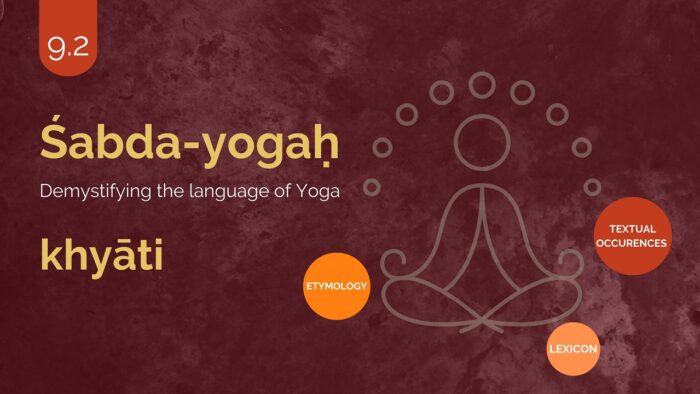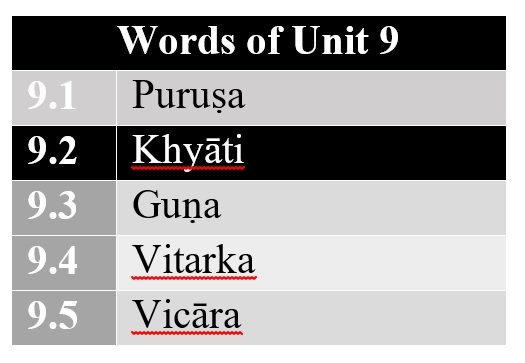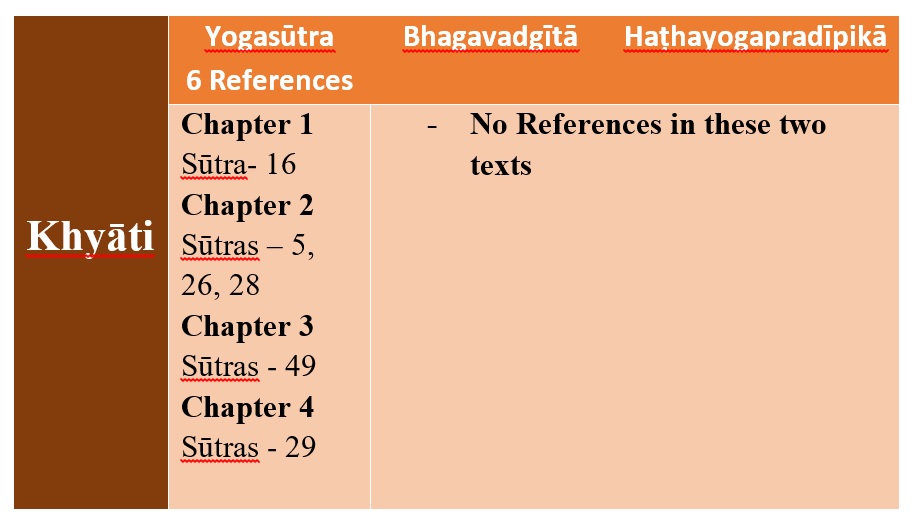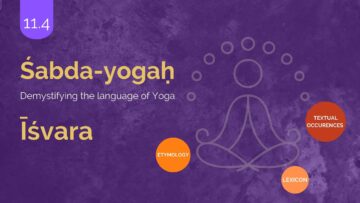Introduction
In this series, Yogic terminologies will be taken up and their –
- Etymological analysis,
- Lexical descriptions and
- Textual occurrences in Yogic literature and their commentaries, as available, will be presented. And finally observations will be made on the references.
Three texts – Yogasūtra, Haṭha-yoga-pradīpikā and Bhagavad-gītā are consulted for textual occurrences portion.
Śabda-yoga is intended to help students, teachers, and professionals of Yoga to develop a sound grammatical, contextual, and thereby an authentic and immersive understanding of Yoga terminologies.
List of Words
From among the above five words for this unit 9, this part discusses the second word khyāti.
Etymology
ख्या + क्तिन् = ख्यातिः
khyā + ktin =khyātiḥ
- ख्या khyā is the root that means प्रकथन – to explain, to make famous to elocute
- क्तिन्ktin is the suffix, it is added by the Grammatical rule – स्त्रियां क्तिन्striyāṃktin (अष्टाध्यायी3.14) – the meaning added to the root by this suffix is भावbhāva – the act
- The derivative statement based on this is – ख्यायते इति ख्यातिkhyāyateitikhyāti – the act of explaining, knowing, understanding
Lexicon
In amarakośa one entry is found –
…प्रथाख्यातौ – 3.2.9
…prathākhyātau
Prathāand khyāti refer to fame.
Textual occurrences
Yogasūtra
There are 6 occurrences of the term in Yogasūtras. It is interesting to note that this term is found in all the four Pādas of this text. A chapter wise summary of these occurrences is presented hereunder.
Pāda 1
तत्परं पुरुषख्यातेर्गुणवेतृष्ण्यम् ॥ १.१६ ॥
tatparaṃpuruṣakhyāterguṇavetṛṣṇyam .. 1.16 ..
Here the term khyāti is used in the context of the Para – Vairāgya – higher state of dispassion. SadāśivaBrahmendra (one among the commentators of the text) describes khyāti as साक्षात्कारःsākṣātkāraḥ – direct realization – in this context. And most other commentators agree upon this interpretation. Commentators inform that this khyāti is said to arise from the teachings of the guru and also the Śāstra-s. This khyāti becomes more clear by reaching the state of Saṃprajñātasamādhi.
Pāda 2
अनित्याशुचिदुःखानात्मसु नित्यशुचिसुखात्मख्यातिरविद्या ॥ २.५ ॥
विवेकख्यातिरविप्लवा हानोपायः ॥ २.२६ ॥
योगाङ्गानुष्ठानादशुद्धिक्षये ज्ञानदीप्तिराविवेकख्यातेः ॥ २.२८ ॥
anityāśuciduḥkhānātmasunityaśucisukhātmakhyātiravidyā .. 2.5 ..
vivekakhyātiraviplavāhānopāyaḥ .. 2.26 ..
yogāṅgānuṣṭhānādaśuddhikṣayejñānadīptirāvivekakhyāteḥ .. 2.28 ..
In Sūtra 2.5 the expression ātmakhyāti is found. This term is part of the definition of Avidyā. Knowing the Non-ātman as the ātman (anātmaniātmakhyāti) is also an expression of āvidya.
In Sūtra 2.26 the expression vivekakhyāti is found. This is a very critical concept in yoga. Viveka here refers to the firm discriminative discernment that Draṣṭā and Dṛśya are different from each other. It is only by this – the state of Hāna or Kaivalya is reached. The self-same term is used in the Sūtra 2.28 also where the practice of limbs of Yoga gradually leads to vivekakhyāti.
Pāda 3
सत्त्वपुरुषान्यताख्यातिमात्रस्य सर्वभावाधिष्ठातृत्वं सर्वज्ञातृत्वं च ॥ ३.४९ ॥
sattvapuruṣānyatākhyātimātrasyasarvabhāvādhiṣṭhātṛtvaṃsarvajñātṛtvaṃ ca .. 3.49 ..
This Sūtra from the third pāda speaks of the sattvapuruṣānyatākhyāti – the clear knowledge that the intellect (Sattva) and the consciousness (Puruṣa) – are distinct from each other. Saṃyama on this leads to the ability to control all beings and omniscience.
Pāda 4
प्रसंख्यानेऽप्यकुसीदस्य सर्वथा विवेकख्यातेर्धर्ममेघः समाधिः ॥ ४.२९ ॥
prasaṃkhyāne’pyakusīdasyasarvathāvivekakhyāterdharmameghaḥsamādhiḥ .. 4.29 ..
This sūtra speaks about the attainment of dharmameghasamādhi. It is attained by the having detachment in Prasaṃkhyāna – the powers mentioned in Sūtra 3.49 is Prasankhyana according to SadāśivaBrahmendra. When these powers are disregarded, vivekakhyāti becomes very firm and this leads to dharmameghasamādhi that culminates in Kaivalya.
Bhagavadgītā & Haṭhayogapradīpikā
This term is not found in these two texts.
Tabulation on Distribution of References in Yoga Texts
Observations
It could be understood that from among the three types of Yoga texts – the term Khyāti is found only in the Yogasūtras. Even in Yogasūtras we see four kinds of khyātis (knowledge/understanding).
- Puruṣakhyāti – direct perception of the Consciousness.
- Anātmaniātmakhyāti – erroneous perception (avidyā) of the consciousness in that which is not consciousness.
- Vivekakhyāti – discriminative discernment. It is interesting to note that this khyāti has been given two adjectives – aviplavā – firm sarvathā – at all conditions. This leads to Kaivalya. The attainment of Vivekakhyāti is facilitated by the eight limbs of Yoga.
- Sattvapuruṣānyatākhyāti – The knowledge that the intellect and the consciousness are different from each other. This is said to lead to extraordinary power of knowing and controlling everything.
Thus as evident from the references and discussion it becomes very clear that Khyāti is a very important concept in Yogasūtras which has implications right from Avidyā to Kaivalya.
Unit 9 To be Continued…
Links for previous posts in this unit
Disclaimer: The opinions expressed in this article belong to the author. Indic Today is neither responsible nor liable for the accuracy, completeness, suitability, or validity of any information in the article.













